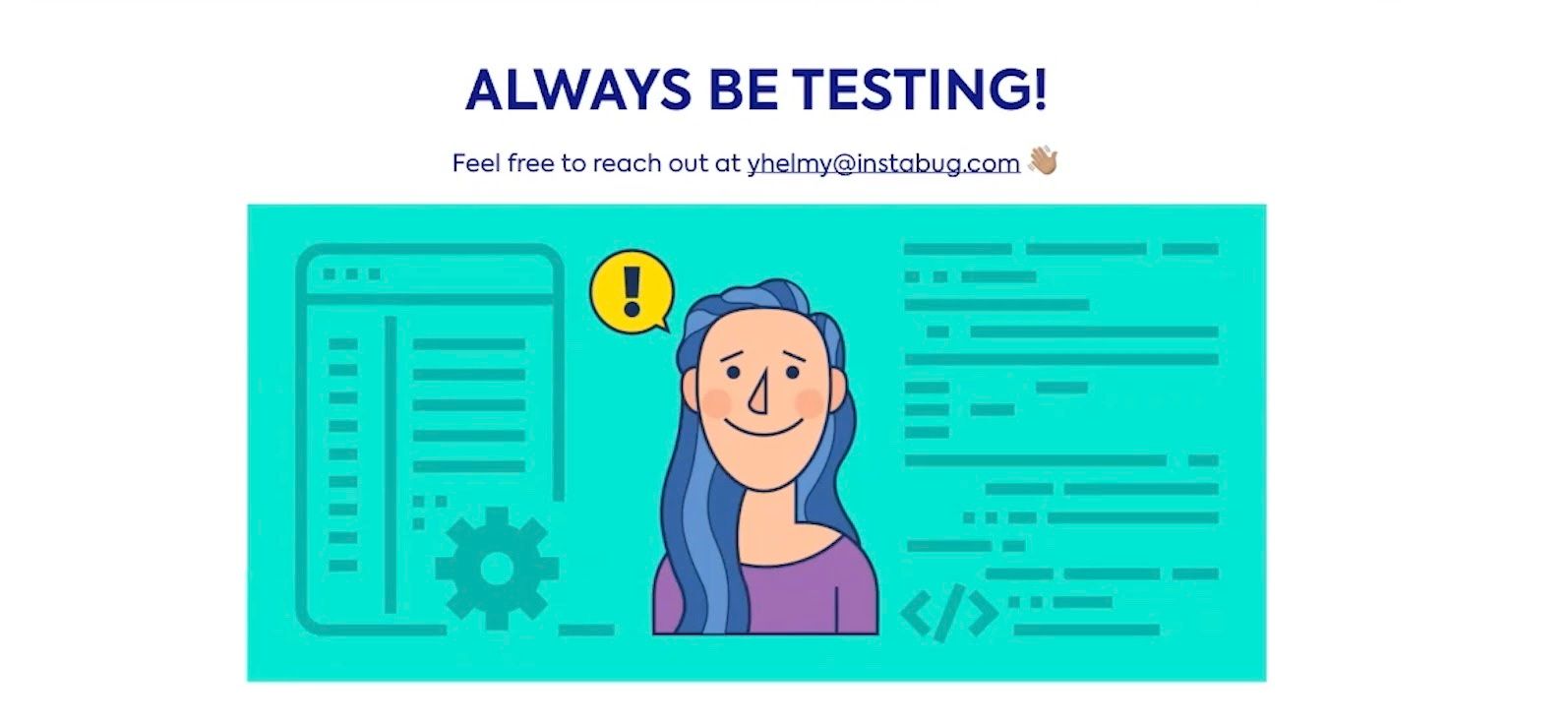Yasmine Helmy is currently the Head of Global Growth at Trella, at the time of writing this Yasmine was Growth Marketing Lead at Instabug.
When I first started out at Instabug, I knew nothing about growth marketing, and having joined one of the most technical startups out there, embarked on my journey in growth.
In this article, I’ll explain how to build your first growth engine, the process and how it’s super important, and the key steps taken along the way, plus some great tools to include in your growth stack.
My name's Yasmine Helmy, I'm from Cairo, Egypt, and in this article, I'm going to talk about building your first growth engine.
Most startups or SaaS products on the market, when they first start out, the founders usually feel like okay, now we have an MVP, we know the persona we want to go after and basically want to start driving in revenues and driving in growth.
That's where they embark on the mission to start a growth engine or a growth team. This is exactly what I've been doing for the past five years.
About me
Before jumping in and talking about the growth engine itself, let me introduce myself. When I started out at Instabug, the company I'm currently leading growth at, I didn't know anything about growth marketing.
I was majoring in Business Administration, focusing on generic marketing, the typical advertising digital marketing you would learn. I didn't have any technical background and ended up joining one of the most technical startups someone could join.
So this is a disclaimer for anyone who's embarking on the journey to start growth - you don't have to have a technical background. Rest easy, it's all about the process.
About Instabug
First of all, I want to introduce what Instabug is because most of my examples will be related to Instabug, I'll be giving some fictional numbers, but it relates in a way to what I want to get out of the article.
At Instabug we help or empower mobile teams to release their applications with confidence without them having to worry they have any bugs or crashes on their app.
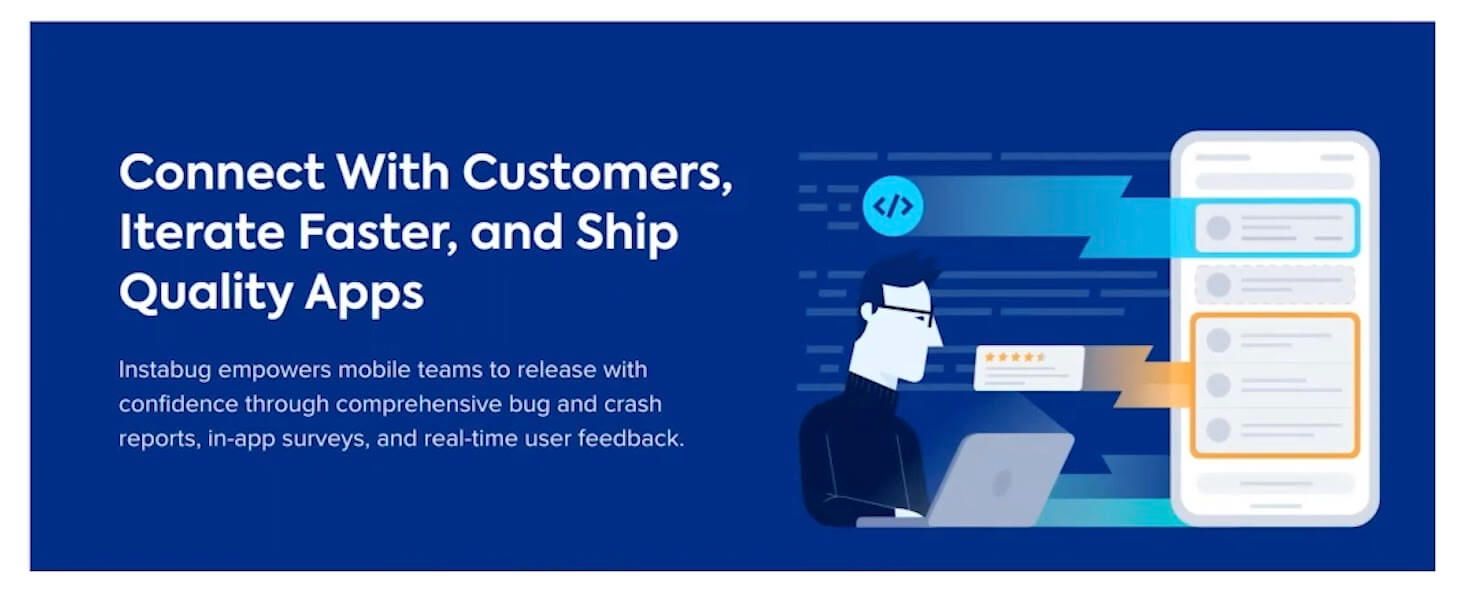
The problem mobile teams usually face when they launch their apps or launch a new release, if the application is buggy, most people will either give a very bad review or entirely delete the app and be done with it. That's something we want to help mobile teams eliminate.
Also, we want to make sure the mobile teams, whether they are in product management or in engineering roles, have access to talk to their beta testers and end-users through an intuitive in-app experience.
In a nutshell, Instabug is a B2B company, selling Software as a Service. Our software helps other businesses who have mobile applications to make sure their apps are flawless and their customers are enjoying the experience.
Instabug 101
When I joined, the first thing I did was a market scoping to see where Instabug fits, why it was built, and who it was built for, to be able to identify the things we should focus on to start our growth engine.
I had this list of questions, these questions will help you very high level understand where you should start, so to speak.
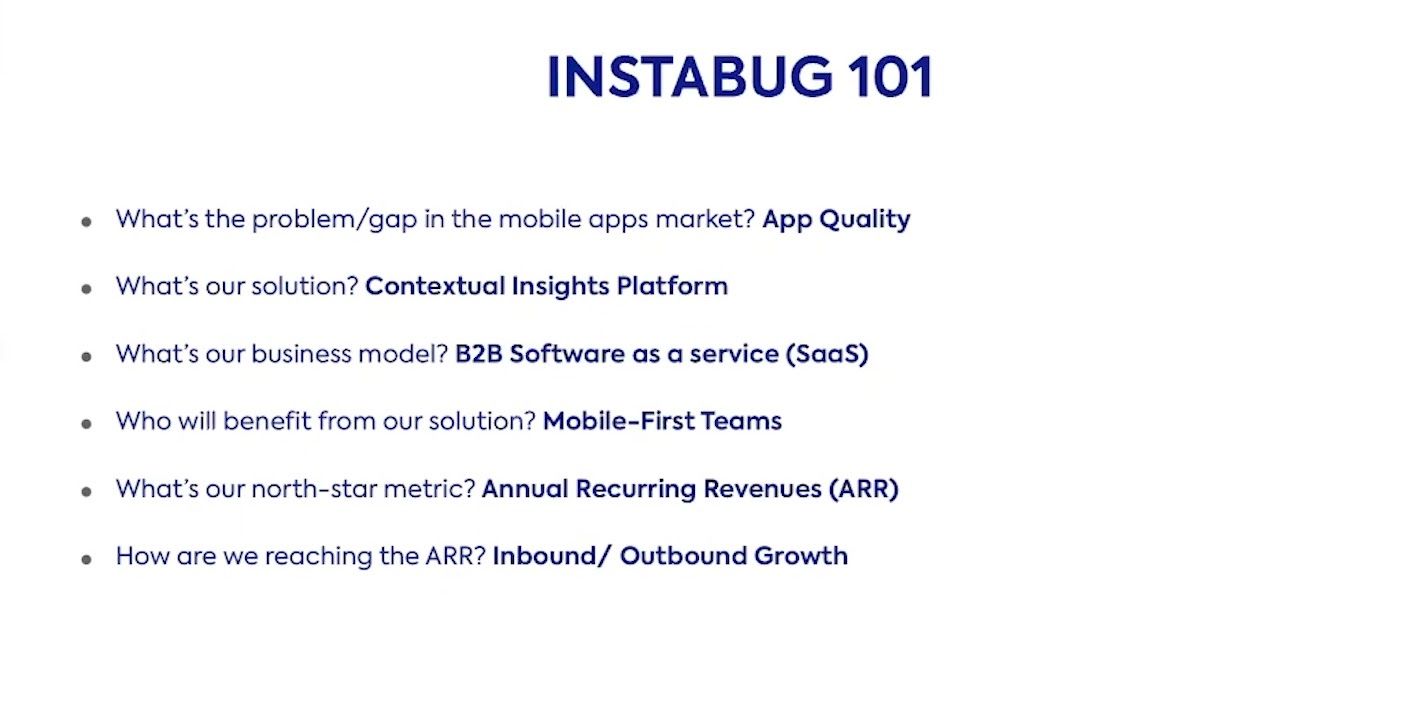
What’s the problem/gap in the mobile apps market?
One of the first things I had in mind which stems from the company's mission itself and why the company itself was built, was I wanted to understand the exact problem or gap we were solving and for and in which market.
In our case, it was the mobile apps market. Definitely, for any industry or any market you're penetrating, you would have some stats on how big it is, who the main players are, the main challenges in this market. That's something we did research on thoroughly to understand the mobile apps market as a whole.
App quality
We wanted to penetrate the gap, which was app quality. In the apps market, there are tonnes of tools that help with engagement, in developing the products faster, making sure the apps are released on time but we saw a gap where some of the apps that are used by millions of users and apps that everyone is actually liking have issues and aren't the best of quality.
That was the first thing I noticed, and what any one of you needs to have very clearly. Because obviously, if you tell me what the gaps in the market are that you're currently focused on, you can go on and on about the problems you see and what things you could enhance, but to clearly articulated it in one or two words will help you later to understand exactly what needs to be done.

What’s our solution?
The second thing was if there's this gap, what would be our solution? When we started out, it wasn't the same solution you can see in the image, but we thought since there is a problem in app quality, we're building a bug reporting solution where anyone who encounters a bug would have an easy way to report it.
Contextual insights platform
Later it transitioned into us building a platform that gives context to the teams working on this platform, with the relevant insights to help them iterate faster, and make their apps better and produce higher quality apps.
What’s our business model?
B2B Software as a Service (SaaS)
The business model, as I told you is a B2B SaaS model.
Who will benefit from our solution?
The people who are going to benefit are mobile teams, not just any mobile team, but teams who are focused on mobile-first, their bread and butter is mobile.
Mobile-first teams
They are entirely focused on making sure their apps function. The interesting part about you doing this, even if it seems very simple, is it gives you a chance to uncomplicate the things that usually complicate in your mind because when you're starting out as a founder, an early member, or just founding the growth team a lot of ideas would be running in your head, you'll feel like it's a bit complicated.
At the end of the day, it needs to be super clear to your so it will be clear to your users as well.
What’s our north-star metric?
The thing we're focused on most, the north-star metric, is annual recurring revenue.
Annual recurring revenue (ARR)
Since we're a subscription model, our main metric is to get customers to pay a certain subscription, and based on that average revenue, we calculate how much we are expecting annually. That is the number we're basing everything we breathe and live on.
How are we reaching the ARR?
To reach this annual recurring revenue, the ARR, we have two options - whether to do inbound or outbound growth, I'll dissect this more later in the article but we were thinking should we go inbound, should we go outbound, and under each pillar, there are tonnes of other activities, strategies, and tactics we could do.
Inbound/outbound growth
Simply put, we knew if you want to reach the annual recurring revenues, we have to delve into the inbound and outbound growth options that we could find.
What's the first thing to do in growth, or setting your engine? There are two things done in parallel.
1. Goal setting
Doing a goal-setting workshop - where you're having the company aligned on the goals that are going to be part of the KPIs for the growth team. To do it, there are two ways - top-down and bottom-up.
Top-down
The top-down is the company itself decides on a metric they need to achieve by the end of the year. Assuming we have a target of 100k and based on the pricing plans we've devised for the SaaS model, we know the average revenue per user for the self-serve is around $100.
Doing a math calculation means on average, I need to get in this year around 83 paying customers to pay me on average $100 for 12 months so that I'd be able to hit the target. That's top-down, you just start with the metric you want to get.
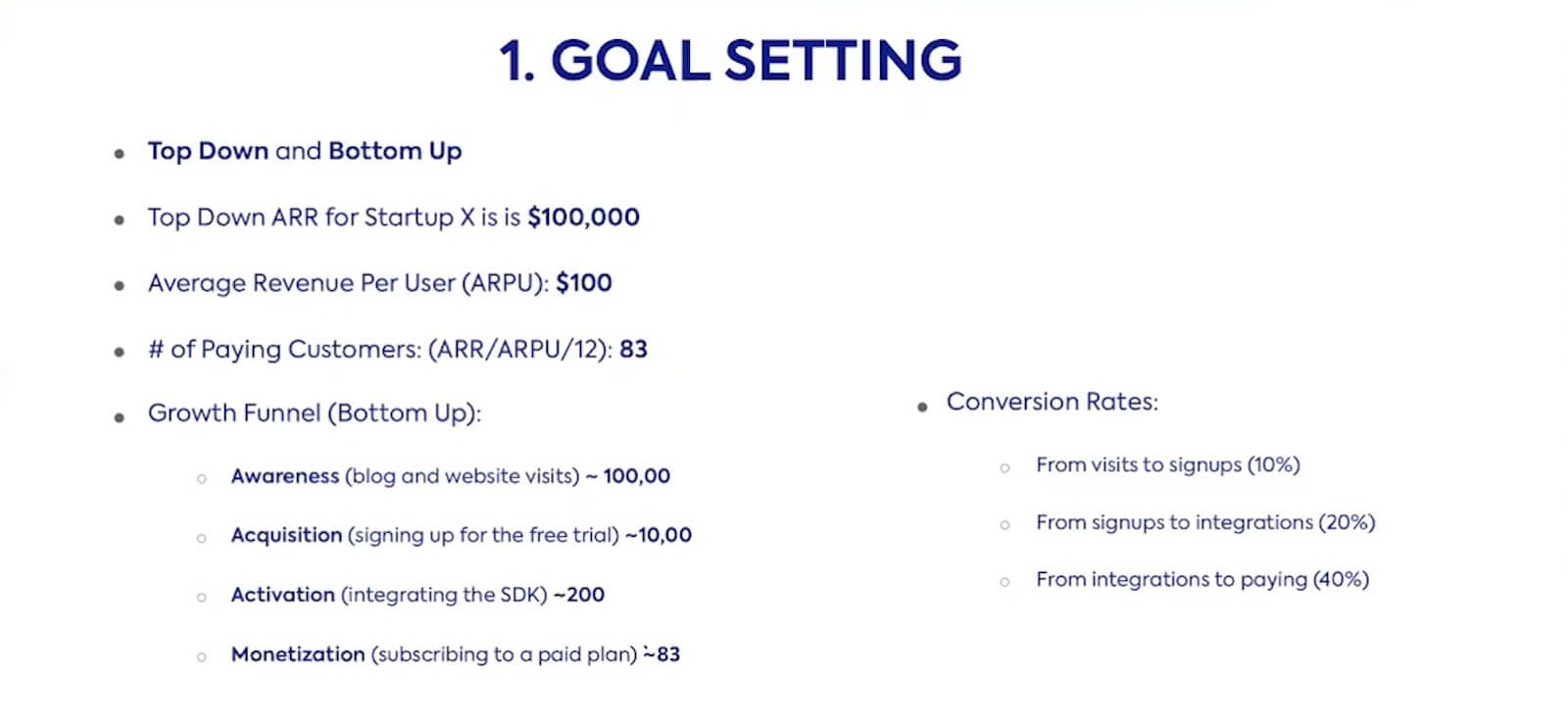
Bottom-up
Bottom-up, meaning that for any successful growth team to work, it needs to have a sales funnel or it needs to have a funnel, where you know the numbers you have to get in order to achieve the results you're looking for.
In that case, the bottom-up approach is basically the 83 customers you're getting, when you start out it's not just a start point and an endpoint, it's more there are checkpoints in the middle.
So if you are to get 83 paying customers, as this example shows, that means not everyone that is going to know about you is going to actually get to the point where you monetize them. That's where the funnel is built.
Assumptions & Industry benchmarks
Two things you could do here, if you're starting out, you need to build a lot of assumptions on the benchmarks and the conversion rates from one step to the other. Also, you need to do competitive analysis and see the industry benchmarks to be able to see if you can get the assumptions you've put for the conversion rates along with the benchmarks for the industry.
In that case, if subscribing to a paid plan out of 200, 40% pays, that means that you need to get 200 to actually activate them to be able to pay the subscription you have in mind. To get this number you need to get people, acquire them and in our case, get them to sign up for a free trial.
You need to get around 1,000 signups and from the 1,000 signups, you on average would need to get around 10,000k website visits. So you could do it by the conversion rates, if you know that the industry benchmark out of all the visits you would get, you would get 10% to sign up, which means, later on, you'll be able to get this funnel.
The value of goal setting
Goal setting helps you in a way if you're starting out to identify the funnel itself, and to see whether this funnel makes sense for you to start on or not.
Because at one point, you might say, "Hey, I don't have the resources to actually get this amount of blog and website visits". So you either have to re-assess whether you need to do more activities or to get more people, or maybe the 83 paying customers wouldn't be feasible, or maybe you need to enhance the conversion rate so instead of focusing on activities that will take a lot of time to convert, focus on other activities.
That basically starts as the core mandate of how you proceed with the growth engine as you go further down the line.
2. Data analysis
The second point is to do data analysis. If you're just started out, data analysis would be to put some assumptions. Once you do some iterations and some campaigns, you start to ask yourself some questions to see whether you're on the right track, or you need to do some adjustments.
I've taken the funnel we just worked on and put it in a way so I would be able to ask myself a bunch of questions. And the team would ask themselves, whether the activities we're going to work on would make sense for us to start it or not.
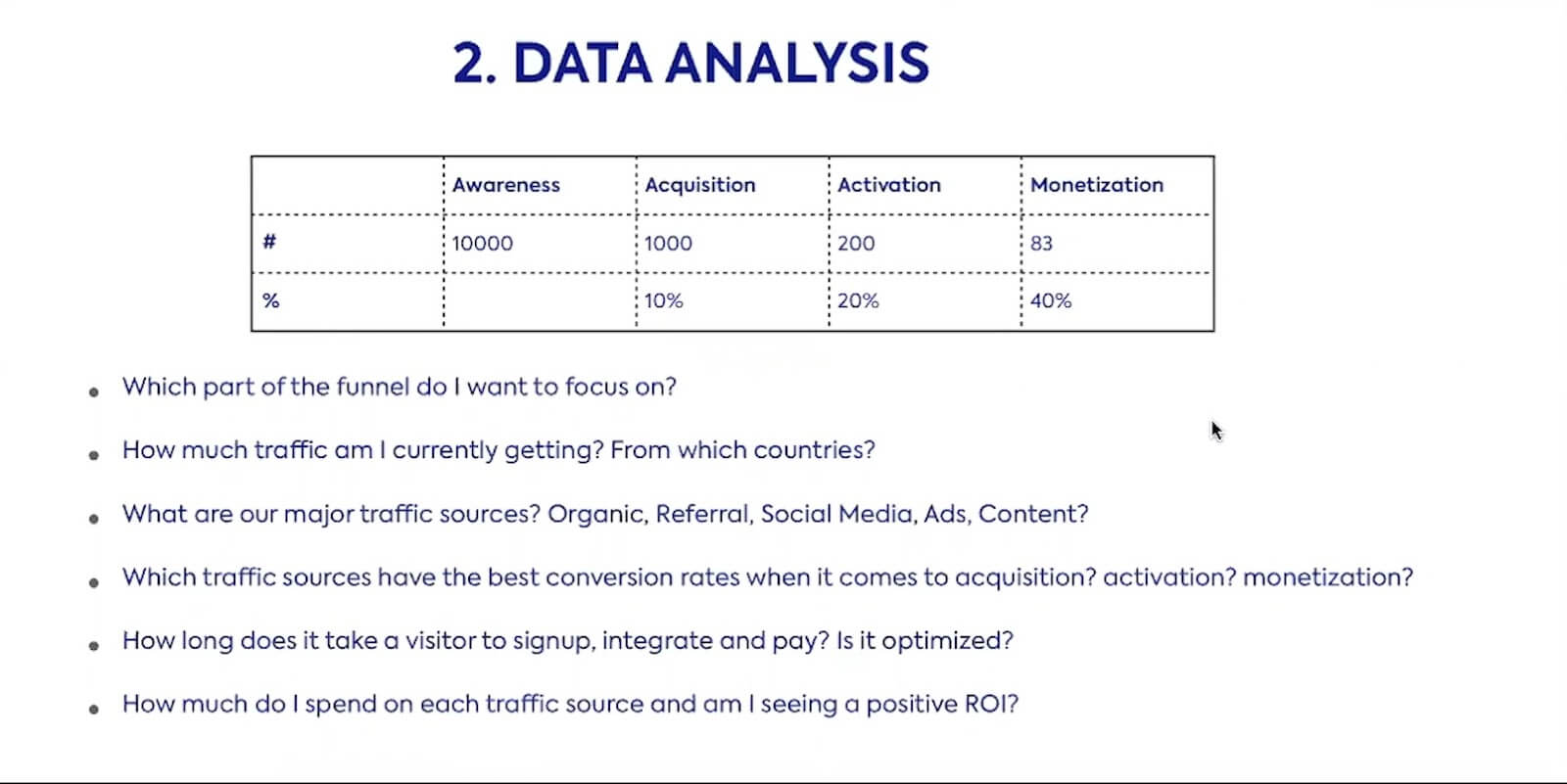
Which part of the funnel do I want to focus on?
When you start out the engine itself, you start thinking about which part of the funnel you want to focus on. Did you already do some activities where you have people that are aware of your product and have visited your website, or maybe checked a blog or something on social media you posted, or you have people who you engaged with.
Then you want them to take the next step of the funnel, where they decide which acquisition activity would be acquisition. In our case, if you have enough people who checked out the website, the second logical step would be to sign up for a free trial.
You have to do two things here, you have to identify and map which activity goes along with the different parts of the funnel. The funnel itself might include more than the four steps I have here because the typical funnel would include retention and referrals as well and they could come in different orders.
But for the sake of this example, I've added these four steps.
How much traffic am I currently getting? From which countries?
Also, you need to understand how much traffic are you getting and from which countries, you will have different sources of getting traffic and getting awareness if you focus on the first part of the funnel, which is awareness and acquisition.
You need to have another funnel that's divided by the different sources and the different countries if you're a global product or you have a different market for your SaaS product. You have to see the conversion rates and the total numbers as well.
What are our major traffic sources?
Asking this question will help you identify which traffic sources are the best for you. Maybe it's organic, maybe it's referrals, maybe it's a combo of social media ads and content. At first, it will be assumptions and you'll have to test it out. But as you go along, you start to feel like
Which traffic sources have the best conversion rates when it comes to acquisition?
But the caveat here is that in every step of the funnel, you need to check the traffic source. In some cases, if you are getting a lot of traffic from social media and ads, you have to see whether this traffic converts the same into acquired customers or activated customers or actually paying customers.
If it's the case that in some traffic sources, or in some examples, you get a lot of aware people, but they don't convert then maybe it's good to do this activity for brand awareness and to actually have some leads that might be interesting down the line. But they're not the best ones to convert now, because they don't have intent.
So understanding which part of the funnel you're focusing on, and mapping this to the traffic sources and the different activities you do, definitely helps you understand how you could enhance things further.
One other point that you should consider here is which traffic sources have the best conversion rates, as I was telling you earlier, and you have to mix between the ones who affect the whole funnel, and you have to also be able to focus on the top of the funnel as well.
How long does it take a visitor to sign up, integrate, and pay? Is it optimized?
Another point to consider is how long does it take a visitor to sign up, integrate, and pay? If you're doing activities for a month, or two or three, what's the cohort itself? In our case, if someone visited the website, and we push them to sign up, usually the sign up for the free trial takes 14 days for them.
We tried different days, we had a seven-day trial and a 14-day trial and tested which one worked best. Eventually, the winner was 14 days so nowadays anyone who's signing up for Instabug gets a 14-day trial. Throughout these 14 days, we start to check the activity, whether they activated the SDK or not, integrated our product into their apps, or are they adding more people to the platform.
If we find them active we know a percentage of them will be activated and then, later on, they might be monetized. If not, you just need to know why it's not happening so you need to put a window where you test the different parts of the funnel you are focusing on.
Maybe the window would be days, maybe the window would be weeks or months, you have to take a decision on how many days or months or weeks you are going to wait to see the results. Take all the channels and all the activities you're working on and see how long they take and how well they do.
Also if they're optimized or not, in one case, you might need to optimize the length of the trial or maybe you need to optimize the onboarding or you need to make sure you're pushing
them to pay so maybe you need to try different offers. Knowing this info is very important for you to be able to make decisions based on the type of insights you get.
How much do I spend on each traffic source and am I seeing a positive ROI?
If you're spending a budget, you definitely need to figure out which traffic sources you're spending the most on and whether you're seeing a positive ROI. You have to understand in each part of the funnel how much you're spending to get this person, lead, or prospective customer.
Let's say I have 10 people who checked my blog and I paid $10 to get them to check the blog. That means on average, it takes you $1 to get one visit to the blog. Out of these 10 people if only one of them signs up that means the signup takes $10.
That is very helpful in identifying whether or not the cost per sign-up or the cost per integration or the cost per acquisition itself makes sense or not.
Because sometimes you are misled by finding a campaign that has a very, very low cost per impression or cost per click or whatnot. But then when you look down the funnel, you find out that it doesn't convert at all. Versus you focusing on another channel that may be the cost per awareness or cost per acquisition is a bit high but then it normalizes as they eventually subscribe. You have to balance out between both.
3. Process
The third thing you should focus on is the process.

Brainstorm all possible channels where you can pull the right persona
I keep on saying if you're just starting out, that means you don't know which of the campaigns or activities you're working on are best. You and your team needs need to brainstorm all possible channels that are super focused on the persona.
When I started out, I was talking about how at Instabug we were focusing on which personas and our ideal customer profile were basically mobile-first teams. But on the mobile-first teams, there are a lot of titles, there are a lot of different personas you can tackle.
For us, we had to get two to three different personas and for each persona, we brainstormed all the possible channels where we could hit this right persona. One channel would be, "Okay for this persona, we can do content marketing and these are the type of topics that would be relevant to this persona and so on".
As opposed to doing meetups with that persona or doing events, digital ads, microsites, or doing something with the engineering team to personalize the experience itself, or integrate a product like Intercom or Drift on the website or the app to do conversational marketing and try to convert these people.
In all of these activities, you need to brainstorm, and you need to prioritize them based on the goals. Whether you're focused on awareness at the moment, top of the funnel, if you just started you need to focus on top of funnel first and see how the top of funnel performs later on.
Prioritize the channels based on your goals
If you have already done some awareness, and you're focused on acquisition, activation, or monetization, you need to know which goals are now the focus to be able to prioritize the channels accordingly.
Select the top 2-4 channels to experiment with
Also, it depends on how big the team is, if you're a team of one to three people, it doesn't make sense to try all the channels at the same time, you need to choose a maximum of two to four channels to experiment with.
The ICE model
There are tonnes of models that will help you choose which one makes more sense. The ICE model basically scores each activity based on the impact, confidence, and ease that each member of the team sees.
In the end, you see the sum of the different impact, confidence, and ease of each of the experiments. This is basically how you start with the first couple of channels you want to experiment with.
Breakdown all the tactics possible for each channel, resources needed, expected metrics, budget and ROI
Under each channel, there are tonnes of tactics that you could do. In content as a channel, you can have different types of content, media, and distribution tactics. And for each of the channels, you need to put all the different possible tactics, the resources:
- Are you going to need engineering help?
- Are you going to need design?
- Are you going to purchase a tool?
- Is there a specific budget you need?
And also if you have a budget, then:
- What would be the ROI?
- What would be the cost for getting someone? And also
- Are you going to focus on metrics here to focus on acquisition or activation or monetization?
Process in practice: an example
As an example, let's say one of the team members decided to go for meetups and they want to validate whether it makes sense or not. Before going into meetups, you can do research to figure it out, for example, one persona would be developers enjoy going to meetups so I'm going to research all the meetups available I can attend as a sponsor, a partner, or as an attendee, to talk about the solution I'm offering.
After doing research, you find out there are 30 possible meetups that would be worth your while. In each meetup on average, there are around 200 attendees. Before even thinking of doing anything related to meetups, you can just do a funnel and see whether it works or not.
Actual vs. expected
Assess it against the actual versus expected. Expected here is to multiply the number of meetups by the number of attendees. On average, you will get a pool of 6k developers who will see you.
Impressions
I added here impressions, just like doing an ad on Facebook where it tells you you'll be seen by potentially 6k people, that doesn't mean all of them will know about you, or all of them would do an action, but it just means you will be present in front of this number.
Based on industry benchmarks, maybe some assumptions, or the brainstorming session we said, "Hey, you know what, out of this 6,000 people were expecting that maybe 20% of them would actually go on the website after we tell them about our product and they would visit a landing page or a blog that maybe we tell them about".
So on average will get around 1,200 to visit. Then based on the benchmark we have for the funnel, we know out of the 1,200, 10% would convert and sign up for the free trial. Out of these signups, some will integrate and some will pay. If each meetup costs £1,000 and we're going to spend $30,000 to be able to participate in these meetups, that means for each visit it's going to cost us $25. Same for signups, same for integrations, and same for paying.
Is it worth it?
The question here would be is it worth it to do something like meetups or is it better to spend the money elsewhere? In the first part of the question, definitely you need to calculate the cost versus the ROI. Here the ROI is that one paying customer costs you around 3k.
But then earlier in the article I said on average, each person pays $100. That means if you multiply the 10 by the 100, you'd be getting 10k, which means you are going to spend 30k, for you to get 10k. That doesn't make sense.
Either you need to figure out a way to bring the pricing of the meetups down, or maybe figure out a way to make the conversion rates better. Maybe you're going to spend anyways because you feel like some of the activities you will do will not be entirely based on the specific CPA, the cost per acquisition, or maybe the cost to the lifetime value or the number of people who will be paying.
Credibility & brand equity
Some activities you need to do to establish credibility and brand equity and to basically be known in the community. In our case, after we check all the other pillars and activities we're thinking of, we might end up choosing to do meetups just for the sake of having brand equity or credibility in the meetups.
Or maybe one of these paying customers would pay more than the $100. Also, the lifetime value itself, when I multiplied it, it was 10 customers paying $100 for 12 months, but maybe the lifetime value is 24 months. That means maybe I break even at some point, maybe after the year.
But it's usually preferable to have the payback period in a period where you can break even. That said it's not a breakeven scenario here, it's more you making sure the ratio between the budget you're spending and the actual results you're getting is at least two to one, if not higher, to make the efforts you're spending worthwhile.
Traction
Let me shift gears here. A lot of people will be asking, "How do I choose the different tactics I will work on, or maybe the channels I will build my engine on?"
There's a book called Traction and this book basically rounds up all the different traction channels you could work on, there are almost 19. They go everywhere from inbound content, to SEO, to trade shows, to business development, to conversion rate optimization, to performance marketing, it includes everything you could think of.
In each case of them, it shows you the different industries that made use of specific traction channels. Each industry is different so I rounded up some of the different traction channels that worked for a SaaS product like ours.
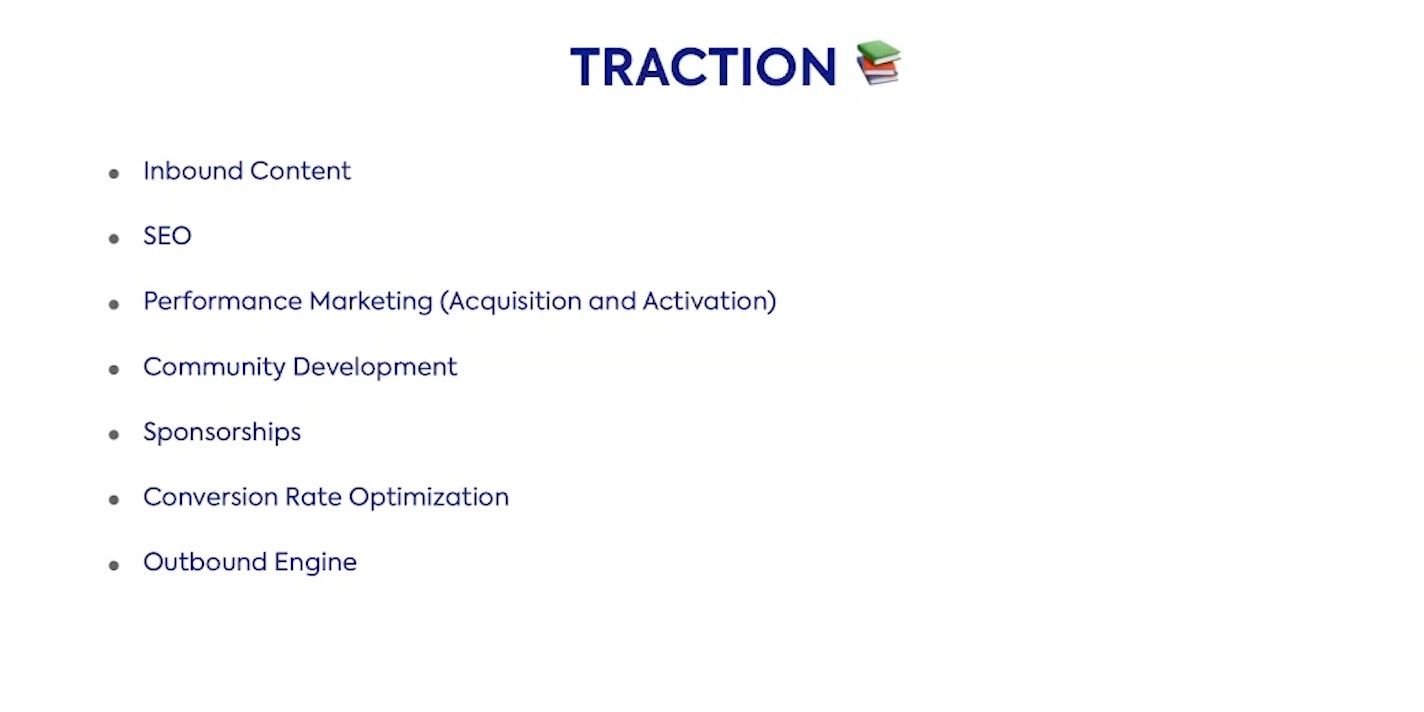
Inbound content & SEO
We relied heavily on inbound content, doing a lot of search engine optimization, where we basically tried to enhance our technical SEO standing, we tried to enhance the keywords we were adding on the pages.
Performance marketing
We were trying to acquire more organic customers through SEO, and also doing backlinks, and making sure our domain is ranking very high.
Community development
We already did a lot of community development because when we did thorough research on our persona, we discovered they really like having a virality effect or word of mouth.
They would make better decisions when they talk to their peers so we wanted to be part of the community so whenever anyone is asking about our product we would know from a fellow developer.
Sponsorships
Also, we focused a lot on sponsorships, sponsorships here were really a different take since we're SaaS, we're digital, we're online, we're selling to the whole world. We wanted to couple community development through sponsorships and whenever we found out there's a specific influencer or someone highly regarded in the community, we wanted to partner up.
Whether they are producing content, doing podcasts, or newsletters, we always wanted to be there showcasing our product.
Conversion rate optimization
We also focused on conversion rate optimization.
If already we get a lot of aware leads or prospective customers, how can we enhance the experience later on?
- Should we focus on doing different landing pages?
- Signups?
- Should we focus on doing a different onboarding flow?
- Should we focus on doing an activation campaign?
And so on and so forth.
Outbound engine
An outbound engine is also something we experimented with because we wanted to reach out to specific companies that we know would make use of our product.
These are all the channels we worked on and experimented with.
Failed learnings: not all channels worked
To be honest, we've experimented with other channels that didn't work in our favor. As I mentioned at the beginning, there were a lot of failed learnings at Instabug, and one of these was us doing a referral program, where we got marketers that are affiliates to promote our product.
It didn't make sense after we did the experiment, because later on when we did an analysis, and we checked the insights, we figured out that our persona is really tech-focused and they needed tech people to be the ones talking to them about the products, not marketing people.
Since the product is very technical, the referral program didn't make much sense.
Brand ambassador program
We iterated on the referral program and we made it a brand ambassador program or a developer program, where basically developers who are interested in getting free additions to the existing subscription they have or maybe have more features, they'd be referring us to other developers.
We ended up taking something that didn't work for us, and we iterated on it to make sure it worked in another way. Or we could have killed the project entirely, know it's not the best for us now, and we can revisit it later on down the funnel.
Documentation of experimentation is key
A very interesting thing here is whenever you try any experiment, you need to document it very well, you need to say:
- This is the channel,
- This is what I'm looking for,
- This is my hypothesis or theory,
- These are the KPIs I'm going to look at, after I finished the campaign or experiment. And
- This is the timeline.
More often than not, when you first start out, you're going to miss a lot of the assumptions that you made. Maybe you put a wrong funnel, maybe it takes you more time than you expect, or maybe you don't get conclusive results.
However, as time goes by, you start feeling you know which of these channels might turn into engines. Let's say, take the inbound content here, we tried tonnes of different content and now we've figured out that some of the content pieces, or maybe the buckets or the topics we talk about, convert people the most to this type of content, we're going to scale to make sure that anyone who comes and signs up and integrate the product, we will be pushing them this content.
And we'll couple this with maybe retargeting ads and we'll be doing a lot of conversion rate optimization to show them these types of content. This is how you basically start connecting dots together and figure out how to get the channels into one cohesive plan.
Growth stack
One of the most important things about growth is your growth stack. If you're doing growth hacking or growth marketing, it's often synonymous with being hacky and being fast and doing a lot of automation, since you're going to look at a lot of data and do a lot of iterations.
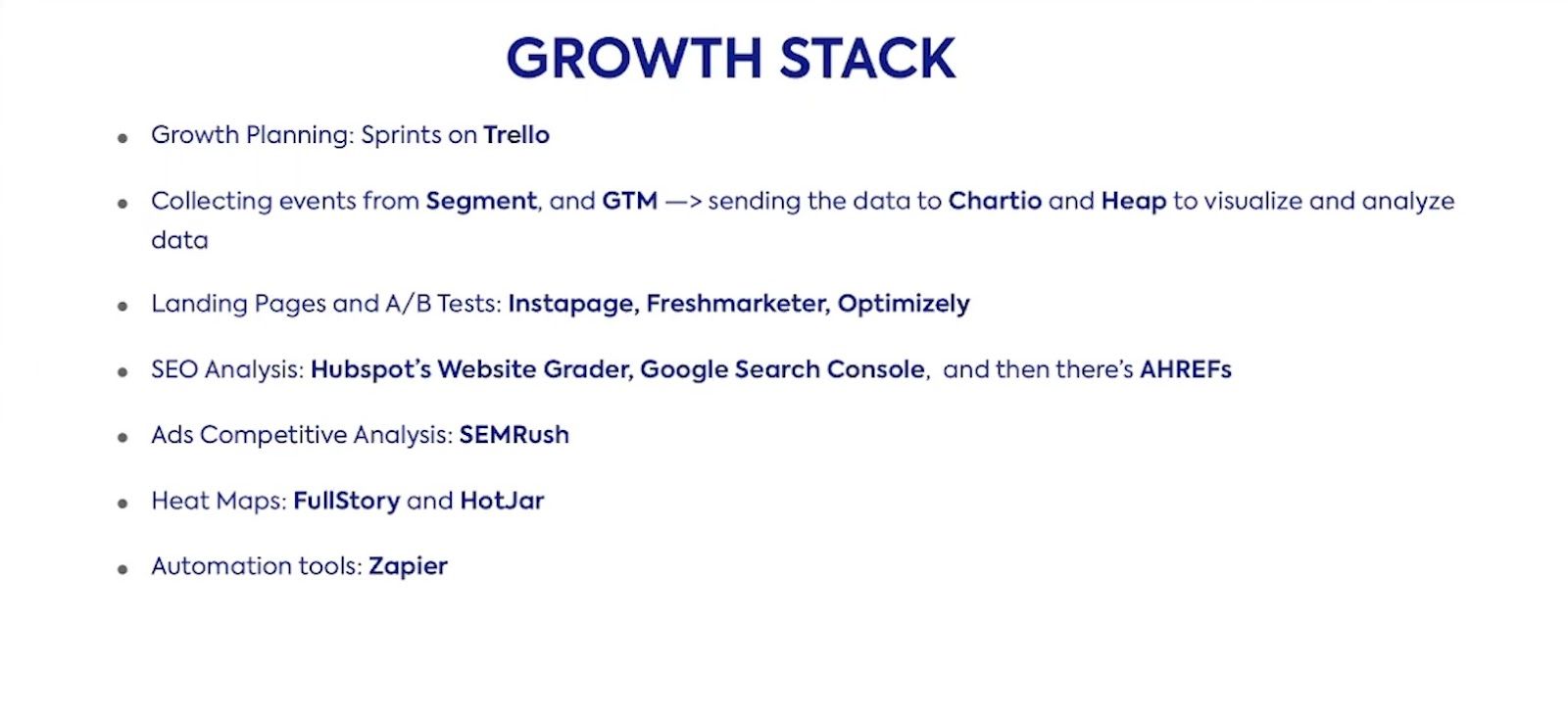
So there are several tools I've rounded. There are many other tools, some of them are free, some of them are more premium. These tools will help you make sure the start of the engine is smoother for you.
Growth planning sprints
One of the first things we do, as I said earlier, whether you're doing a goal setting session or data analysis, or you're setting the process or the campaign itself, you need to have continuous planning with the team.
We're doing it in sprints, meaning each week after we put the yearly goal, and we dissect it into quarterly goals, and weekly goals as well, you start dissecting all the channels you're going to work on into sub-activities.
Each week, you put all the activities you're going to work on in a project management tool, like Trello, for instance. It's basically like post-it notes, you have the to-do list or backlog of ideas, and each week, you pull up the ideas you have already brainstormed on, which ones you're going to work on, which ones are you already working on, and which ones are done.
That helps if you are a big team or even a small team to identify how fast the process is and how fast you're going through the things you're supposed to work on. Did you get it done? Also, it shows you the workload itself and gives visibility to the entire team on who is working on what.
As part of the planning, we do it every week at the beginning of the week, it takes one or two hours. We set a very specific agenda where each person talks about their week, what they worked on, and the results and recommendations.
We also set aside some time to brainstorm new ideas, things we didn't initially think of, or maybe a correcting course, looking at the metrics and seeing whether we're behind or actually doing great when it comes to metrics and we need to be focusing on double doubling down other things.
Planning is very important. Trello is one of the most important tools we use to help us regulate our sprints.
Collecting events from Segment, and GTM
The second thing is anything we do in growth to build an engine, it needs to be scalable, repeatable, and measurable. You need to have a very strong data collection platform.
You could use something like Segment or Google Tag Manager to connect all the data sources together. If you are getting data from different social media platforms, then getting data from ads, the blog, the website, dashboard, etc. you need to connect them all together and basically display this data in an Excel sheet or otherwise.
There are tonnes of visualization and analysis platforms. What you need to do is, the metrics I showed you earlier, whether it's the funnel, whether it's the results, you need to be able to see it on a regular basis.
Sometimes with user behaviors, you want to see the entire funnel of a specific user, Heap helps us with this. All of these tools, if you're just starting out, might have free credits, or they might have startup discounts, then as you grow you start using more of their features.
Landing pages and A/B tests
A third thing that's very important, an integral part of scaling the engine is doing a lot of A/B tests. Even if something works, you need to make sure it gets better so you need to do a lot of A/B tests.
If at some point, you know that, "Okay, my engine would be digital ads, SEO and content". Inside each of these pillars, even if you're scaling, you need to do a lot of A/B tests. A/B testing is to have different assumptions, you have a control and different variables, and you test the variables against the control.
Tools like Instapage, Freshmarketer, Optimizely, are all good. There are other tools I didn't include here as well. If you're an app, it may be Apptimize or Firebase does A/B testing as well.
You want to test for conversion rates, and you want to test to see if there are, for example, time on page bounce rates. There are tonnes of methods you could look for but these tools are very helpful when it comes to iterating and doing enhancements to the conversion rate optimization point.
SEO analysis
SEO is a realm on its own but then if you just want to take a quick look at how your website is performing there's a lot of free graders where you put your URL in and it tells you exactly your score, how Google is scoring you:
- Are you mobile-first?
- Are you optimized?
- Are there certain code snippets you should optimize?
- Maybe images you need to compress?
Also, Google Search Console gives you an overview of the different keywords people are finding you on and also the pages, how are they ranking?
There's a website called AHREFs that tells you how your competitors and how you are performing, what your domain rate is, how many backlinks you're having, which keywords you lost or gained. All of these tools are very, very important in you understanding how your presence is online.
From these tools, you will find you need to do a lot of enhancements. Always keep an eye on how you're performing, especially if you're expecting to get a lot of visits or get a lot of people online.
Ads competitive analysis
One key thing you can do if you're doing a competitive analysis and you need to figure out what your competitors are doing online, whether they're doing ads, or doing different messages, there's SEM Rush which tells you if a competitor of yours is doing ads, the different ads they're doing, how much they're spending on, and what their current bidding is.
That's super helpful in you identifying if you're going into a bidding war on a specific keyword, what to expect, and also what different activities. It helps you be on top of things and understand where your competitors are at.
It helps you generate new ideas on how to beat them with less money and more creative ideas.
Heat maps
Again, for conversion rate optimization and for understanding whether the activities you're working on are working or not, you have to do a lot of heat maps. You need to identify if you're doing a landing page, which parts of the landing page are people most interacting with?
If people drop off after the third fold, then maybe all the interesting info needs to be above the third fold - fold meaning the top header then the second part the third part. Where the CTA should be placed. What what are the things they click on but they're not clickable?
All of these things, you'd be amazed by how simple this is and how a lot of assumptions based on the user experience you and your team create versus what actually happens. User experience is key.
Sometimes we have a lot of assumptions that aren't necessarily correct so you need to be able to validate your assumptions using the heat maps.
Automation tools
Lastly, automation tools, meaning if you have a funnel, and you want to make sure when someone signs up, they go into a specific list, you can do so through Zapier, or maybe IFTTT which is If This Then That.
- If you want to get notified on Slack when someone signs up so you can email this person right away.
- If you want to get them into a manual onboarding campaign.
If you want to integrate one tool with another, to do a specific activity, you need to do a lot of automation. Automation saves the day at the end of the day because there are a lot of low-value activities and high-value activities.
You need to spend most of your time doing high-value activities.
In conclusion
To build the engine, and the process itself, if you are doing sprints, you know the targets you are after, you are doing a lot of experiments and A/B tests, that helps you get on with activities you want to work on. And it gives you more time to look at data.
It doesn't take a lot of time for you to be on top of everything related to growth, what it takes time to do is figure out the right mix of things with the persona, as I was saying earlier.
Building an engine takes time, time here might be months, I'm not talking weeks, but at least the process itself, the experiments, the way you do iterations, the way you look at data, you could set this up in weeks.
Also, you could train your team on how to look at data and how to report data as well and what exactly you are looking for. It could start with a simple funnel, looking at the conversion rates and focusing on one part of the funnel, and then moving down the line to another.
As you go, and as you grow, you start putting more targets when it comes to getting more revenues. It depends on your north-star metric. Maybe if the pricing experiments you do change the average revenue per user that means if the average revenue per user is higher, does this mean the same conversion rates apply or not?
So there are a lot of moving parts, but you having a process in place makes it so much easier, and helps you focus on building the engine itself.
I’ve thrown a lot of information at you. Definitely, there are other things I could talk about for hours. But I wanted to leave you with always be testing, the core mandate of building an engine is to always have an assumption that this engine is always up for testing and this engine, you can optimize all the time.
